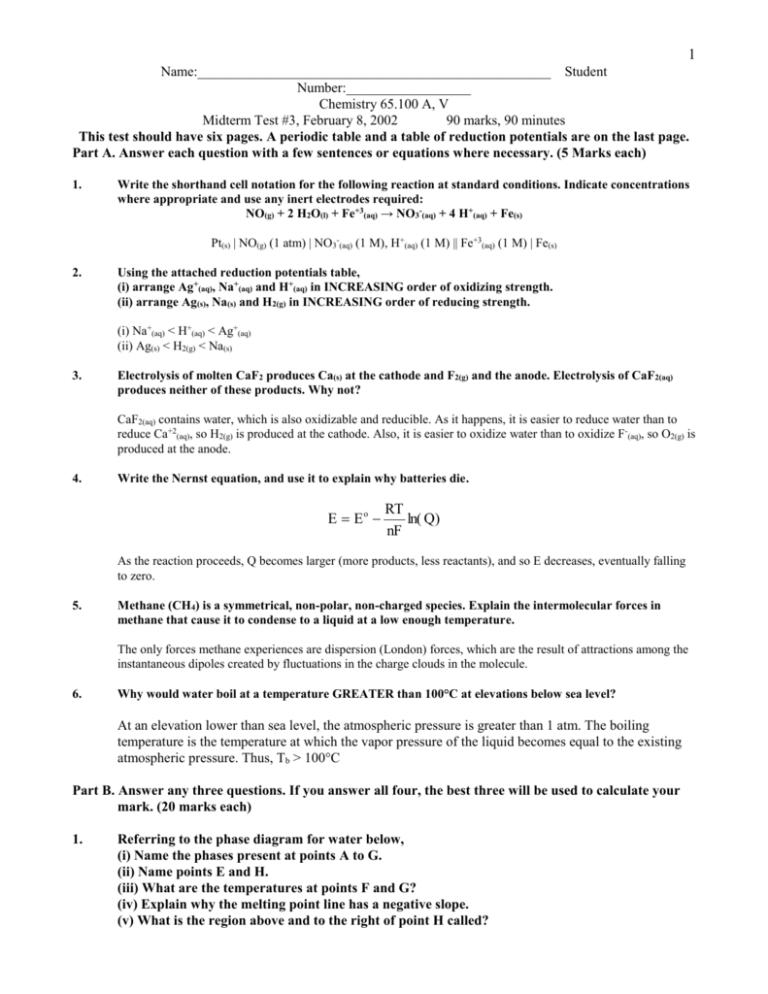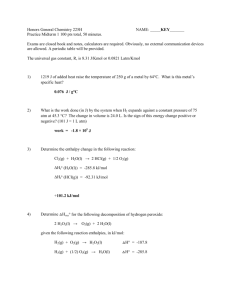Chemistry 65
advertisement

1 Name:___________________________________________________ Student Number:__________________ Chemistry 65.100 A, V Midterm Test #3, February 8, 2002 90 marks, 90 minutes This test should have six pages. A periodic table and a table of reduction potentials are on the last page. Part A. Answer each question with a few sentences or equations where necessary. (5 Marks each) 1. Write the shorthand cell notation for the following reaction at standard conditions. Indicate concentrations where appropriate and use any inert electrodes required: NO(g) + 2 H2O(l) + Fe+3(aq) → NO3-(aq) + 4 H+(aq) + Fe(s) Pt(s) | NO(g) (1 atm) | NO3-(aq) (1 M), H+(aq) (1 M) || Fe+3(aq) (1 M) | Fe(s) 2. Using the attached reduction potentials table, (i) arrange Ag+(aq), Na+(aq) and H+(aq) in INCREASING order of oxidizing strength. (ii) arrange Ag(s), Na(s) and H2(g) in INCREASING order of reducing strength. (i) Na+(aq) < H+(aq) < Ag+(aq) (ii) Ag(s) < H2(g) < Na(s) 3. Electrolysis of molten CaF2 produces Ca(s) at the cathode and F2(g) and the anode. Electrolysis of CaF2(aq) produces neither of these products. Why not? CaF2(aq) contains water, which is also oxidizable and reducible. As it happens, it is easier to reduce water than to reduce Ca+2(aq), so H2(g) is produced at the cathode. Also, it is easier to oxidize water than to oxidize F-(aq), so O2(g) is produced at the anode. 4. Write the Nernst equation, and use it to explain why batteries die. E Eo RT ln( Q) nF As the reaction proceeds, Q becomes larger (more products, less reactants), and so E decreases, eventually falling to zero. 5. Methane (CH4) is a symmetrical, non-polar, non-charged species. Explain the intermolecular forces in methane that cause it to condense to a liquid at a low enough temperature. The only forces methane experiences are dispersion (London) forces, which are the result of attractions among the instantaneous dipoles created by fluctuations in the charge clouds in the molecule. 6. Why would water boil at a temperature GREATER than 100°C at elevations below sea level? At an elevation lower than sea level, the atmospheric pressure is greater than 1 atm. The boiling temperature is the temperature at which the vapor pressure of the liquid becomes equal to the existing atmospheric pressure. Thus, Tb > 100°C Part B. Answer any three questions. If you answer all four, the best three will be used to calculate your mark. (20 marks each) 1. Referring to the phase diagram for water below, (i) Name the phases present at points A to G. (ii) Name points E and H. (iii) What are the temperatures at points F and G? (iv) Explain why the melting point line has a negative slope. (v) What is the region above and to the right of point H called? 2 Pressure, atm F 1.00 . .A . . D .B .H . G .C E Temperature (i) A: Solid B: Liquid C: Gas D: Solid and gas E: Solid, liquid and gas F: Solid and liquid G: Liquid and gas (ii) Point E is the “Triple Point”. Point H is the “Critical Point” (iii) At point F, the temperature is 0°C. At point G, the temperature is 100°C. (iv) The melting point of water decreases as the pressure is increased because the density of ice is lower than the density of liquid water. (v) This region is called the Supercritical Fluid region. 2. and For a hydrogen fuel cell, the reactions are: H2(g) + 2 OH-(aq) → 2 H2O(l) + 2 e- (at the anode) O2(g) + 2 H2O(l) + 4 e- → 4 OH-(aq) (at the cathode) (i) Balance the overall electrochemical reaction. 2 H2(g) + 4 OH-(aq) → 4 H2O(l) + 4 eO2(g) + 2 H2O(l) + 4 e- → 4 OH-(aq) _______________________________ 2 H2(g) + O2(g) → 2 H2O(l) (ii) Calculate the standard cell potential in Volts. Eocell = Eoanode + Eocathode = -(-0.83) + 0.40 = 1.23 V (iii) Calculate the standard free energy change for the overall reaction in kJ/mol. Is this a spontaneous reaction? ΔGo = -nFEo = - 4 mol e- (96487 C/mol e-)(1.23 J/C) = -474716 J/mol = -475 kJ/mol ΔGo < 0, so the reaction is spontaneous. 3 (iv) The actual cell potential is a function of the partial pressures of H2(g) and O2(g). Use the Nernst equation to calculate the cell potential if pH2 = 2 atm and pO2 = 3 atm at 298 K. E Eo Q RT ln( Q) nF 1 1 2 0.0833 p H 2 p O2 2 (3) 2 Thus , E 1.23 V 8.314 JK 1mol 1 (298 K ) ln( 0.0833) 4 mol e (96487 C mol 1 ) 1.23 (0.016) 1.246 V 3. A cylindrical object 5 cm in diameter and 1 cm high is electroplated with gold from a bath containing Au(NO3)3(aq). How long (in seconds) will it take to plate a 0.01 cm thick coating of gold using a current of 1.00 A? The density of gold is 19.3 g/cm3. The surface area of the cylinder object is 2(πr2) + πdh, where r is the radius (2.5 cm) and h is the height (1 cm): Area = 2(π)(2.5 cm)2 + π(5 cm)(1 cm) = 54.95 cm2 The volume of gold to be electroplated is therefore the surface area times the thickness: Volume = 54.95 cm2 x 0.01 cm = 0.5495 cm3 The mass of gold is: mass = volume x density = 0.5495 cm3 x 19.3 g/cm3 = 10.60 g gold The number of moles of gold is therefore: moles gold 10.60 g 0.0538 moles gold 197.0 g mol 1 but the reaction is Au+3(aq) + 3 e- → Au(s), implying that 3 electrons are required to reduce each gold ion. The number of moles of electrons required is therefore 3(0.0538) = 0.1616 mol e-. q = it = nF Thus, t 4. nF 0.1615 moles e (96487 C mol 1 ) 15600 s i 1.00 C s 1 Measurements of the vapour pressure of CS2 gave the following data: - at -5.1°C, the vapour pressure is 100 mm Hg. - the normal boiling point is 46.5°C. Calculate the enthalpy of vaporization of CS2 in kJ/mol. 4 ln( p 2 ) ln( p1 ) or, H vap H vap 1 1 R T1 T2 p R ln 2 p1 1 1 T1 T2 760 100 1 1 1 273.1 5.1 273.1 46.5 K 8.314 JK 1mol 1 ln 27,999 J mol 1 28.0 kJ mol 1 Note that the normal boiling point is where p = 760 mm Hg (1 atm).










